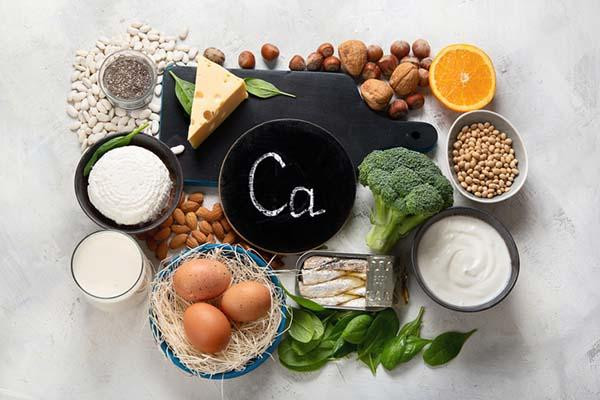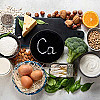Calcium-rich foods: How to boost your intake of this important mineral
- Reviewed by Teresa Fung, MS, RD, ScD, Contributor; Editorial Advisory Board Member, Harvard Health Publishing

Calcium is the most abundant mineral in your body, and it's a major component of your bones and teeth. But your body can't make calcium on its own, so it's essential to consume calcium-rich foods (and, sometimes, supplements) to meet your daily calcium needs.
As with any nutrient, choosing foods with calcium rather than a supplement should be your first choice. Luckily, nature offers a bounty of choices.
Health benefits of calcium
Calcium is best known for building bones and keeping them healthy. But it also plays many other vital roles, like keeping your heart beating and your muscles and nerves functioning, as well as helping maintain healthy blood pressure.
Calcium is so indispensable that your body has a backup system to keep a steady amount of it in your blood to maintain those vital functions, in case of a calcium deficiency. If you don't get enough calcium in your diet, a complex series of reactions will release calcium from your bones into your bloodstream, to go where it's needed. But if this calcium "debt" isn't replenished, it can weaken your bones over time and increase your risk of developing osteoporosis (a disease in which bones become more porous and less dense than healthy bones).
How much calcium do you need?
The U.S. recommended daily allowance (RDA) for calcium depends on age and sex; older adults (especially women) need slightly more, since they're at greater risk of weakened bones. Adults up to age 50 are advised to get 1,000 milligrams (mg) calcium per day; the recommendation is 1,200 mg daily for women over 50 and men over 70.
People who do not eat dairy products, which are rich in calcium, may need to pay careful attention to ensure they get enough calcium through other foods or, in some cases, calcium supplements.
Top dairy sources of calcium
When you think of high-calcium foods, dairy products like milk, yogurt, and cheese probably come to mind first. Indeed, dairy foods are some of nature's most concentrated sources of calcium (see table). And many come "packaged" with other bone-building nutrients like protein, phosphorus, and (when fortified) vitamin D.
The best non-dairy sources of calcium
While they don't get as much fanfare, many plant foods are also calcium-rich, including greens, beans, tofu, nuts, and seeds. Note that some of these healthy foods also contain compounds like insoluble fiber and oxalic acid that bind with calcium and hinder its absorption. For example, some greens like spinach and chard are higher in oxalic acid — but others like kale, collard greens, and bok choy contain lower amounts, so the calcium they contain is likely better absorbed. For that reason, it's important to eat a variety of calcium-containing plant-based foods.
You can also find a variety of plant-based beverages, such as plant milks and orange juice, that have been fortified with calcium.
Calcium-rich foodsThis list contains a variety of nutritious dairy and plant-based sources of calcium. |
|
|
Food |
Calcium (mg) |
|
Milk, dairy (1 cup) |
|
|
Skim |
325 |
|
Whole |
300 |
|
Milks, plant-based (plain/unsweetened, 1 cup) |
|
|
Almond milk, fortified |
482 |
|
Soy milk, fortified |
399 |
|
Rice milk, fortified |
300 |
|
Yogurt (plain, 1 cup) |
|
|
Low-fat |
448 |
|
Whole milk |
296 |
|
Greek, low fat |
270 |
|
Cheeses |
|
|
Ricotta, part-skim (1/2 cup) |
337 |
|
Mozzarella, part-skim (1 ounce) |
222 |
|
Cheddar (1 ounce) |
201 |
|
Cottage cheese, 1% fat (1/2 cup) |
69 |
|
Legumes & legume products |
|
|
Tofu, firm, made with calcium sulfate (1/4 block) |
553 |
|
Edamame (green soybeans), cooked (1 cup) |
130 |
|
Chickpeas, cooked (1/2 cup) |
40 |
|
Navy beans, cooked (1/2 cup) |
63 |
|
Nuts and seeds |
|
|
Chia seeds (1 ounce) |
179 |
|
Almonds (1 ounce) |
76 |
|
Sesame paste (tahini) (1 tablespoon) |
64 |
|
Brazil nuts (1 ounce) |
45 |
|
Vegetables (1 cup, cooked) |
|
|
Collard greens |
324 |
|
Kale |
177 |
|
Bok choy |
158 |
|
Broccoli |
62 |
|
Fruits and juices |
|
|
Calcium-fortified orange juice (1 cup) |
349 |
|
Orange (1 medium) |
65 |
|
Dried figs (4) |
54 |
|
Blackberries (1 cup) |
42 |
|
Source: US Department of Agriculture FoodData Central. |
|
About the Author

Joyce Hendley, Health Writer
About the Reviewer

Teresa Fung, MS, RD, ScD, Contributor; Editorial Advisory Board Member, Harvard Health Publishing
Disclaimer:
As a service to our readers, Harvard Health Publishing provides access to our library of archived content. Please note the date of last review or update on all articles.
No content on this site, regardless of date, should ever be used as a substitute for direct medical advice from your doctor or other qualified clinician.















